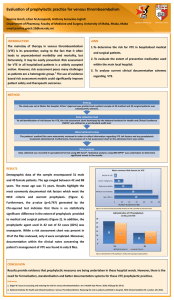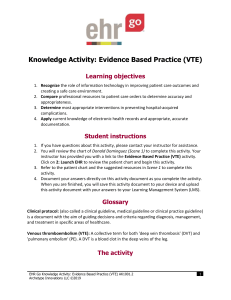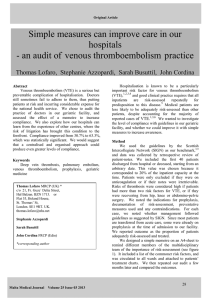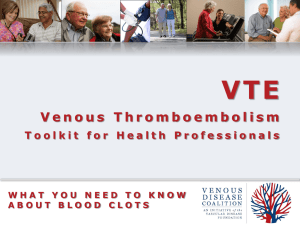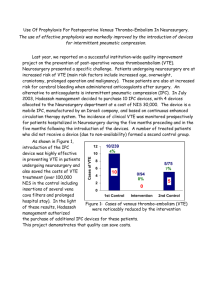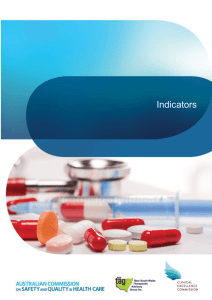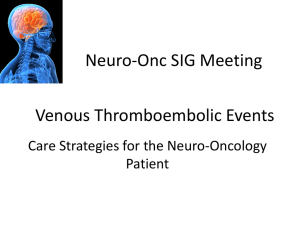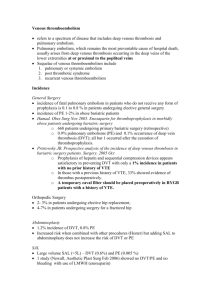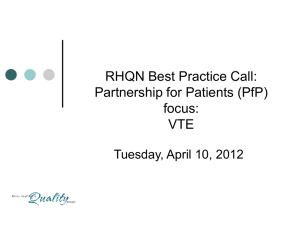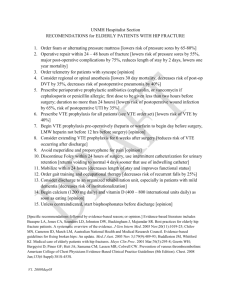VTE – Final April 2012 Category Title Source Description Core
advertisement
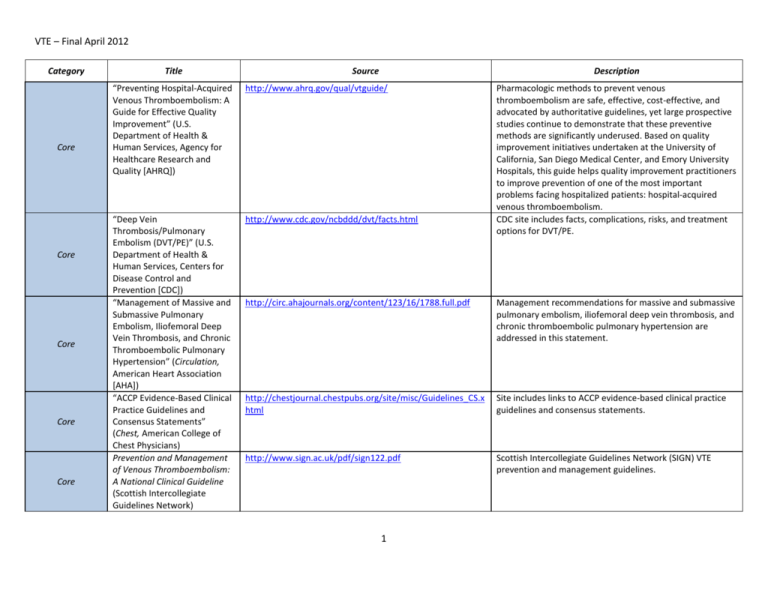
VTE – Final April 2012 Category Core Core Core Core Core Title Source Description “Preventing Hospital-Acquired Venous Thromboembolism: A Guide for Effective Quality Improvement” (U.S. Department of Health & Human Services, Agency for Healthcare Research and Quality [AHRQ]) http://www.ahrq.gov/qual/vtguide/ “Deep Vein Thrombosis/Pulmonary Embolism (DVT/PE)” (U.S. Department of Health & Human Services, Centers for Disease Control and Prevention [CDC]) “Management of Massive and Submassive Pulmonary Embolism, Iliofemoral Deep Vein Thrombosis, and Chronic Thromboembolic Pulmonary Hypertension” (Circulation, American Heart Association [AHA]) “ACCP Evidence-Based Clinical Practice Guidelines and Consensus Statements” (Chest, American College of Chest Physicians) Prevention and Management of Venous Thromboembolism: A National Clinical Guideline (Scottish Intercollegiate Guidelines Network) http://www.cdc.gov/ncbddd/dvt/facts.html Pharmacologic methods to prevent venous thromboembolism are safe, effective, cost-effective, and advocated by authoritative guidelines, yet large prospective studies continue to demonstrate that these preventive methods are significantly underused. Based on quality improvement initiatives undertaken at the University of California, San Diego Medical Center, and Emory University Hospitals, this guide helps quality improvement practitioners to improve prevention of one of the most important problems facing hospitalized patients: hospital-acquired venous thromboembolism. CDC site includes facts, complications, risks, and treatment options for DVT/PE. http://circ.ahajournals.org/content/123/16/1788.full.pdf Management recommendations for massive and submassive pulmonary embolism, iliofemoral deep vein thrombosis, and chronic thromboembolic pulmonary hypertension are addressed in this statement. http://chestjournal.chestpubs.org/site/misc/Guidelines_CS.x html Site includes links to ACCP evidence-based clinical practice guidelines and consensus statements. http://www.sign.ac.uk/pdf/sign122.pdf Scottish Intercollegiate Guidelines Network (SIGN) VTE prevention and management guidelines. 1 Category Core Title Source Description “Venous Thromboembolism (VTE)” (Hospitals in Pursuit of Excellence) Venous Thromboembolism Prevention: Getting Started Kit (Safer Healthcare Now!) http://www.hpoe.org/topic-areas/vte.shtml Site includes links to various hospital case studies. http://www.saferhealthcarenow.ca/EN/Interventions/vte/D ocuments/VTE%20Getting%20Started%20Kit.pdf “Blood Clot Education for Patients & Professionals” (National Blood Clot Alliance: Stop the Clot®) “Map of Medicine®: Venous Thromboembolism (VTE) Risk Assessment (All Patients)” (National Health Service [NHS]) “NICE Pathways: Venous Thromboembolism Overview” (NHS, National Institute for Health and Clinical Excellence [NICE]) Preventing Hospital-Acquired Venous Thromboembolism: A Guide for Effective Quality Improvement (Society of Hospital Medicine) “Venous Thromboembolism Prevention Resource Centre” (Australian Commission on Safety and Quality in Health Care) “Learn about Venous Disease” (Vascular Disease Foundation: Venous Disease Coalition) “Venous Thromboembolism (VTE) Prevention in the http://www.stoptheclot.org/ This Getting Started Kit (GSK) has been written to help engage your interprofessional/interdisciplinary teams in a dynamic approach for improving quality and safety while providing a basis for getting started. The VTE GSK represents the most current evidence, knowledge, and practice, as of the date of publication, and includes what has been learned since the first kits were released in 2008. Link to an organization that is dedicated to DVT/PE prevention. It includes blood clot education for patients and professionals, links to news articles, and various events. Core Enhanced HPH HPH HPH HPH Supporting Supporting http://healthguides.mapofmedicine.com/choices/mapopen/venous_thromboembolism_vte_risk_assessment_and _prophylaxis1.html Site includes a VTE risk assessment algorithm. http://pathways.nice.org.uk/pathways/venousthromboembolism NICE Pathways is an interactive tool for health and social care professionals, providing fast access to NICE guidance and associated products for VTE prevention. http://www.hospitalmedicine.org/AM/Template.cfm?Sectio n=Home&Template=/CM/ContentDisplay.cfm&ContentID=1 7773 Site includes information from the Society of Hospital Medicine on effective quality improvement techniques for VTE prevention. http://www.safetyandquality.gov.au/internet/safety/publish ing.nsf/Content/vte-prevention Site includes resources and tools from the Australian Commission on Safety and Quality in Healthcare for VTE. http://www.venousdiseasecoalition.org/ Organization promotes public and health professional awareness of venous disease. Site includes information on the disease, membership, resources, and events. Site includes a link to Dr. Greg Maynard’s slide presentation on VTE prevention. http://www.ahrq.gov/qual/vtepresentation/maynardtxt.htm 2 Category Title Source Description Hospital” (AHRQ) Supporting Supporting Prevention and Treatment of Venous Thromboembolism (VTE) in Obstetrics (Society of Obstetricians and Gynaecologists of Canada) Venous Thromboembolism (VTE) Prophylaxis in Pregnancy and the Puerperium (Queensland Government) http://www.sogc.org/guidelines/public/95E-CPGSeptember2000.pdf A 2000 clinical practice guideline reviewed and approved by the Maternal Fetal Medicine Committee and the Council of the Society of Obstetricians and Gynaecologists of Canada. http://www.health.qld.gov.au/qcg/documents/g_vte5-1.pdf Queensland Maternity and Neonatal Clinical Guideline prepared to promote and facilitate standardization and consistency of practice using a multidisciplinary approach. 3
